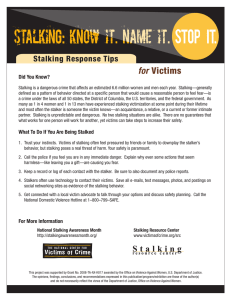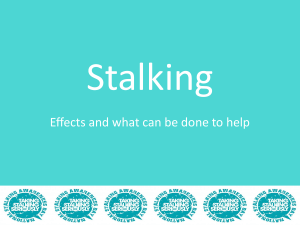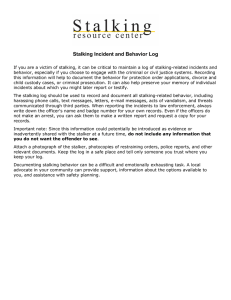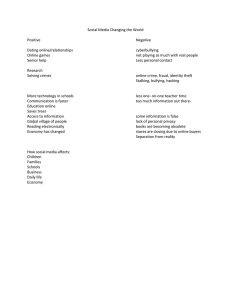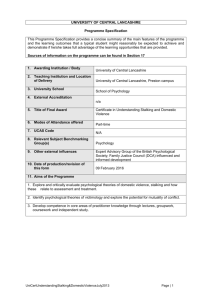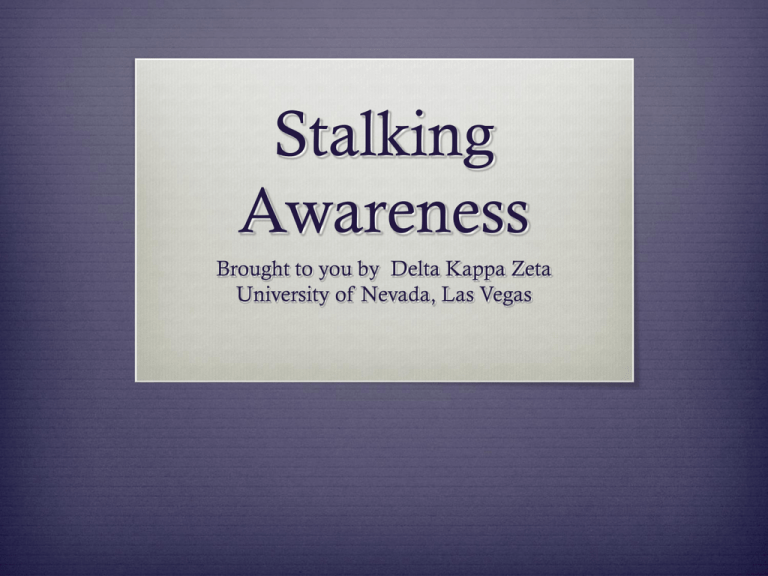
Stalking
Awareness
Brought to you by Delta Kappa Zeta
University of Nevada, Las Vegas
Stalking Definitions
In Nevada, stalking is defined as when a person
performs a series of acts over time that reasonably causes
you to reasonably feel terrorized, frightened, intimidated,
harassed, or fearful for your safety, or the safety of your
family or household member.
Aggravated stalking is when a person commits the
crime of stalking (as defined above) and also threatens
you with the intention of making you reasonably fear
death or serious bodily harm.
Stalking: Victims
Both men and women may be victims of stalking
It is estimated that 3.4 million men and women are
victims of stalking each year
More than half of stalking victims are under 30 years
of age
Women are 3 times more likely to the stalked than
raped
Safehorizon.org
Stalker: Perpetrator
3 in 4 stalking victims know their stalkers as either a
current or former spouse or partner, roommate, coworker, family member, or social acquaintance.
Females are more likely to be stalked by a males (67%)
than another female
Men have reported that 41% of their stalkers were male,
while 43% reported their stalkers were female.
Safehorizon.org
Impact of Stalking
Almost half of stalking victims have at least one
unwanted contact with stalker per week
11% of stalking victims report being stalked for more
than 5 years
1 in 4 victims report being cyberstalking (e.g, email, text)
More than half of stalking victims report losing time
from work because of stalking
FBI Law Enforcement Bulletin 2010
Dangers of Stalking
Violence may occur between 25% to 35 % of stalking cases (McEwan et al,
2007)
76% of intimate partner femicide victims have been stalked by their intimate
partner.
67% had been physically abused by their intimate partner.
89% of femicide victims who had been physically assaulted had also been
stalked in the 12 months before their murder.
79% of abused femicide victims reported being stalked during the same period
that they were abused.
54% of femicide victims reported stalking to police before they were killed by
their stalkers.
Victimsofcrime.org
US statistics of Stalking
Estimated 1.5% of persons +18 were victims of
stalking.
Individuals who were divorced or separated are more
likely to be stalking victims than those who have
never been married or widowed
7 in 10 victims know their offender in some way
Females are more likely to be stalked than males;
however, females and males were equally likely to
experience harassment.
U.S Department of Justice:
http://www.bjs.gov/index.cfm?ty=pbdetail&iid=1211
Common Victim concerns
The stalking will lead to physical and/or sexual
assault
Stalking won’t stop or if it has stopped, will recur
Stalking will cause significant psychosocial damage
McEwan et al., 2007
Stalking Behavior
Stalking behavior may vary and may impact victims in different ways
For example:
Following, surveillance, spying
Standing, loitering: victim's home,
school, place of work etc.
Verbal abuse or public humiliation
Unsolicited: mail, postcards,
photographs, gifts from the endearing to
the bizarre
Going through rubbish bins. Leaving
offensive material in the garden
Breaking into victim's car, home or
office
Interfering, damaging personal
belongings
Threatening your freedom by making
false allegations to the police
Repeatedly texting, emailing, leaving
voicemails
Planting spyware, viruses into your
computer
Hacking into your computer, email,
social media accounts
Spreading rumors, discrediting
Threats or violence against the victim,
family, friends or pets
Damage to property, stealing victims
belongings
Physical violence, sexual assault, rape,
murder
“Befriending” victim's friends, family to
get closer to the victim
Invading your personal space by
standing too close or brushing against
you
Laws on Stalking on US
Stalking is a crime under the laws of all 50 states, the District
of Columbia, the U.S. Territories, and the Federal government.
Less than 1/3 of states classify stalking as a felony upon first
offense.
More than 1/2 of states classify stalking as a felony upon
second offense or subsequent offense or when the crime
involves aggravating factors.
Aggravating factors may include: possession of a deadly
weapon, violation of a court order or condition of
probation/parole, victim under 16 years, or same victim as
prior occasions.
Victimsofcrime.org
Nevada Laws on Stalking
A victim can file a petition for an order for
protection against stalking and harassment if
someone is stalking or harassing.
No attorney is required to get an order but it is
recommended.
There is no fee to file for and order for protection
and to have the order served on the abuser if they are
in Nevada
“Under Nevada law, harassment and stalking is
considered to be committed in the place where the
acts occur or in the place where the victim is located
at the time s/he is harassed or stalked.”
Nevada Stalking Laws cont.
EXAMPLE: If you live in Nevada and the abuser lives in
Arizona, “if the abuser sends you a threatening text
message or email and you receive it in Nevada, the
harassment can be considered to have been committed in
Nevada.”
If victim believes abuser has violated the order, they can
immediately call the police.
If abuser has been served with a copy of the order, the
police can immediately make an arrest.
Womenslaw.org
Clinical Implications
There is no consensus among victim-assistance providers
about standards of practice in how to help them (Logan,
Walker, et al., 2006; Spence-Diehl & Potocky-Tripodi,
2001).
Researchers argue that developing an approach that builds
on the client's understanding of their own situation and
views service providers as consultants in the client's
decision-making process is needed.
There is a small amount of research that supports the
assertion that allowing victims more voice and control
leads to more positive outcomes (Zweig & Burt, 2007;
Bellknap & Sullivan, 2002; Hotaling & Buzawa, 2003).
Clinical Implications Cont.
Clinical practice should be conducted with an explicit understanding that what
works today may not work tomorrow, and contingencies for future contact with
sources of help should be outlined. Clinicians should also pay close attention to
victims' assessment of their own safety and offer assistance in ways that honor
individual victim's circumstance and personal understanding of risk.
Research also indicates that victims have a good understanding of their own level
of risk and that they do not appear to be in denial (Cattaneo & Goodman 2007,
Cattaneo, Bell, Goodman & Dutton, 2007; Heckert & Gondolf, 2004; Kropp,
2004; Weisz, Tolman & Saunders, 2000).
In order to effectively assist victims of stalking, more information on the
individual case is needed to understand which strategies will work and identify
when and how they may work.
Safety accounts for more than 30% variance in the rate of change of mental
health over time.
Safehorizon.org
Resources
Safehorizon.org
Womenslaw.org
Victimsofcrime.org
The CARE Line at UNLV:
http://www.unlv.edu/srwc/groups/care
Contact the Crimes Against Persons Bureau at
L.V.M.P.D. for harrassment/stalking/protective orders at
(702) 229-5635
References
Belknap, J. & Sullivan, C.M. (2002). Longitudinal study of battered women in the system: the victims’ and decision-makers
perceptions, final report. Rockville, Maryland: National Institute of Justice/NCJRS Paper Reproduction Sales.
Botuck, S., Berretty, P., Cho, S., Tax, C. A., Archer, M., Catteneo, L. B. (2009). Understanding intimate partner stalking: Implications
for offering victim services. Unpublished Report.
Bulletin Reports. (2010). FBI Law Enforcement Bulletin, 79(2), 22-2
Cattaneo, L.B., Bell, M.E., Goodman, L.A. & Dutton, M.A. (2007). Intimate partner violence victims’ accuracy in assessing their risk
of re-abuse. Journal of Family Violence, 22(6): 429-440.
Cattaneo, L.B. & Goodman, L.A. (2007). New directions in IPV risk assessment: an empowerment approach to risk management. In
Kendall-Tacket, K.A. & Giacomoni, S.M., Intimate Partner Violence (p. 1-31). Kingston, NJ: Civic Research
Institute.
Heckert, D.A. & Gondolf, E.W. (2004). Battered women’s perceptions of risk versus risk factors and instruments in predicting repeat
reassault. Journal of Interpersonal Violence, 19(7): 778-800.
Kropp, P.R. (2004). Some questions regarding spousal assault risk assessment. Violence Against Women, 10(6): 676-697.
McEwan, T., Mullen, P. E., & Purcell, R. (2007). Identifying risk factors in stalking: A review of current research. International
Journal Of Law & Psychiatry, 30(1), 1-9. doi:10.1016/j.ijlp.2006.03.005
Spence-Diehl, E., Potocky-Tripodi, M. (2001). Victims of stalking. Journal of Interpersonal Violence, 16(1):86-94.
Weisz, A., Tolman, R. & Saunders, D.G. (2000). Assessing the risk of severe domestic violence: the importance of survivors’
predictions. Journal of Interpersonal Violence, 15(1): 75-90.
Zweig, J. M. and M. R. Burt (2007). "Predicting Women's Perceptions of Domestic Violence and Sexual Assault Agency Helpfulness:
What Matters to Program Clients?" Violence Against Women 13(11): 1149-1178.

